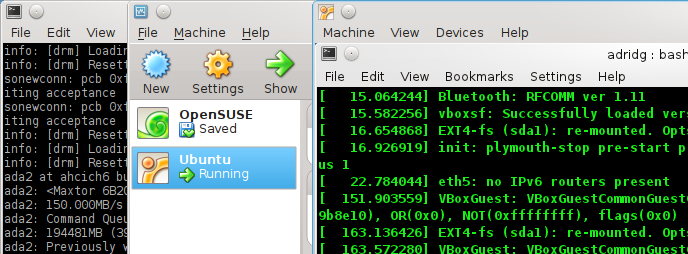Yo, dogg, about those HDDs
HDD cleanup continues apace. I did like the wisecrack about semantic storage -- although it's not quite correct, since these are drives removed from otherwise decommissioned machines, or tarballs rolled of my university student account before the departmental Solaris server was decommissioned. It's more like moving boxes never before opened (I know there's several that I moved house with 8 years ago that are still awaiting an opening moment). In the mean time I've discovered a bunch of academic papers I had forgotten I had ever written and a bunch of OCaml I wrote that I no longer understand, as well as several versions of my bachelor's thesis written in the winter of 1998.
Anyway, while futzing about with all these drives I've set up my main machine as FreeBSD 9.2-STABLE, running KDE 4.10 (which is as new as the KDE-FreeBSD ports are -- 4.11 introduces some interesting new breakage which hasn't been dealt with yet). I could repeat what I wrote several years ago: with KDE on top, noone knows what you're running underneath and the applications and environment do all you need. And it's nice having a very-close-to-vanilla-upstream desktop.
I bunged some more memory into the machine, and now I get the interesting effect that a VM plus its root disk image can fit into main memory. OpenSUSE has an amazing boot time if
/dev/sda is secretly already in RAM.
But the niftiest thing I have discovered recently is VirtualBox raw disk access. This means I can (hot-) plug a drive into my machine and boot that physical drive in a VM. The setup is relatively painless, requiring only a little care with permissions and a complicated command-line. Here's a screenshot of, left-to-right, FreeBSD dmesg showing me that I've switched on /dev/ada2 -- a 200GB drive with Kubuntu 11.10 on it from when I was briefly a Python/Qt contract programmer -- with VirtualBox and then the running Kubuntu session with its own idea of the physical disk. Hearing the physical disk rattle when I do something in a virtual machine is kinda cool, and this makes it much, much easier to figure out what files are interesting on any given drive.
But this bumps me into an interesting corner regarding KDE desktop settings and configuration. I've got a new desktop here. I've got an old desktop in the VM, and there are a bunch of settings that I'd like to transfer from the old desktop to the new one. Let's disregard whole-desktop settings right now. Aaron Seigo recently posted something on his Google+ about Plasma-desktop settings transfer, which is promising next time I want to move my settings (focus follows mouse, yellow-and-orange wallpaper, no activities, 4 virtual desktops) to a new installation. I'm talking about application settings. For instance, I have a working Blogilo in the VM -- what do I need to do to get the same Blogilo settings in another machine? That means copying the blog configurations and the passwords. So where do they live?
The userbase page for KMail has information about moving settings around; that's the only instructions I could find for moving application settings. Those instructions are also somewhat incomplete, since passwords are probably stored in kwallet, and figuring out which stored passwords need to be copied over is a pain in the neck. Or take Blogilo. It has a
blogilorc file, but it doesn't seem to record anything useful in there: no blog URLs, no usernames, nothing. Everything seems to be in kwallet, which exports whole wallets at a time. In other words, I can get at my blogilo configuration by exporting the wallet (unencrypted, plain XML), editing it to remove all the bits I don't want (such as my IMAP passwords) and then importing it on the other machine. This seems error-prone and tedious -- this time, it was actually just as straightforward to simply do all the configuration anew. It strikes me that there would be a market for a menu item Settings->Export all of this application's meaningful configuration. As the computing experience becomes more fluid, moving from device to device, that might become more important -- if I have configured something on my desktop, I want the same KDE application on my tablet to easily, seamlessly, take over the configuration from elsewhere... and, hey, it turns out when I moved house last I used XFig to draw a plan of the house so as to juggle furniture (also in XFig) more effectively. These drives are a veritable trove of joy (and KDE configuration questions).